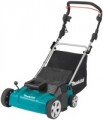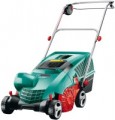Type
The type determines the method of operation and, accordingly, the general purpose and specific application of the aerator.
—
Verticutter(knife). The name comes from the English "vertical cutter" — "vertical blade". In accordance with this, the working tool of the verticutter is a horizontal shaft with vertical blades mounted on it. In the process of work, such an aggregate leaves characteristic slots in the ground, which contribute to the penetration of air, moisture and nutrients into the soil. In this case, the blades cut the roots of the grass, thus stimulating their growth in loosened soil and, accordingly, the growth of the grass itself. In addition, verticutters are good (better than the
scarifiers described below) for removing debris from the surface of the earth. They easily cope with both “lying” debris like wood chips or acorns, as well as with dry grass, moss cover, etc. Therefore, the main purpose of such units is the cleaning of neglected lawns that have not been cultivated for a long time, which require intensive processing. It should be noted that verticutters also include hand-held devices (see "Engine type") with a working tool in the form of characteristic "sprocket" wheels: according to the specifics of work, they are a cross between rake and knife models, however, the teeth of the "sprockets" are more similar on knives than on the antennae of scarifiers, and they penetrate deeper
....
— Scarifier (rake). Aerators of this type work on the principle of a wire rake: like verticutters, they use a working tool in the form of a shaft, but not blades are installed on the shaft, but wire “antennae”. Thus, most scarifiers do not so much work on the soil as they comb the lawn, removing debris from it — like last year's leaves or dry grass. However, there are models that are able to pierce the soil; however, even with them, the depth of influence is very small — up to 5 mm. In general, such units are designed mainly to maintain healthy already “cultivated” lawns that do not require intensive processing.
— Combined. Models that can be used both as a knife aerator and as a rake aerator. Features of both types are described in detail above. And to realize their functions in one aerator, it is possible through the use of interchangeable shafts: by installing the appropriate shaft, the owner can turn the unit either into a verticutter or a scarifier. Note that only those units that are initially equipped with working tools of different types belong to the combined ones. If the possibility of replacement is provided, but there is only one shaft in the kit, the aerator will be assigned to one of the types described above.Working width
The width of the strip processed by the aerator in one pass. The higher this indicator, the faster the device works, the fewer passes will have to be made to process a certain area. On the other hand,
a wide grip noticeably affects the dimensions of the entire structure and makes it difficult to work in hard-to-reach places, if not impossible. Therefore, when choosing a model in terms of working width, it is worth considering not only the overall dimensions of the site, but also its configuration and the presence of tight areas — sometimes it is preferable to sacrifice the performance of the aerator for the sake of its manoeuvrability and patency.
Processing depth adjustment
How to adjust the working depth (for verticutters) or height (for scarifiers, see "Type"). Usually, such adjustment is carried out by adjusting the suspension (in other words, changing the position of the wheels), and its types can be as follows.
—
Synchronous. A method that involves adjusting all four wheels at once. It is convenient because the user does not have to perform numerous actions — just use the switch (for example, move the lever), and the desired height will be set on all wheels of the aerator. On the other hand, synchronous systems are somewhat more expensive and more complicated than manual ones.
— Manual. With manual adjustment, it is impossible to change the position of all the wheels of the aerator at the same time: in some models it is necessary to adjust each axle separately, in others — each wheel. This option is simpler and cheaper than synchronous adjustment, but not as convenient.
Shaft speed
Rotation speed of the aerator shaft in normal operation.
Manufacturers select the shaft speed in such a way that the device is guaranteed to be able to cope with the tasks for which it is designed. So in most cases, this parameter is more of a reference than practically significant. At the same time, for verticutters (see "Type"), it can also have a practical meaning: lower speed, with the same power, provides higher tractive effort and allows you to better cope with dense soils and thick rhizomes. So for such conditions, it is worth choosing a model with lower revolutions, and for a favorable environment, on the contrary, higher (high revolutions have a positive effect on performance).
Working mechanism
The design of the working mechanism provided in the aerator, in other words, the number and types of working elements installed on the shaft. For verticutters (see "Type") such elements are blades, for scarifiers — spring teeth. For
combined models, in this case, the design of both working shafts is indicated, for example "14 knives / 20 spring teeth".
Bag type
The type of waste bag provided with the aerator.
—
Hard. Bags made of a hard material, usually plastic. Such containers are convenient in unloading, moreover, they are more durable than soft ones: a sharp object that has fallen into such a bin will only scratch the wall. The main disadvantages of hard bags are quite heavy and bulky — they cannot be folded or rolled up, as is the case with soft ones. In addition, in the absence of special indicators (see below), it is more difficult to control the filling of such a container than a soft container — in fact, you have to remove it every time and check the amount of garbage collected.
—
Soft. Soft garbage bags are light in weight and easy to store and transport: during non-working hours, such a bag can be folded compactly, and it will not take up much space. In addition, the dimensions of the soft bin are directly dependent on the amount of content in it — in other words, the bag increases in size only as it is filled. In fact, this allows you to monitor the filling in the absence of special indicators (in fact, they are not provided in such models at all), and in general, the small size of the bag is convenient when working. On the other hand, emptying such a container is more difficult than a rigid one, and sharp, hard objects such as twigs, glass fragments, etc. can pierce soft material.
— Is absent. The complete absence of a garb
...age collector in the kit. In such cases, a garbage bag must be purchased separately; on the other hand, its type and volume can be chosen at your discretion. And in some situations, a waste bin is not required at all, and its purchase would only be an unnecessary waste of money.Bag volume
The total volume of the garbage collection bag provided with the aerator.
The larger the bag, the more garbage it can hold, the less often it will have to be emptied. On the other hand, the weight and dimensions of a capacious container will also be considerable (this is especially true for rigid varieties, in which the size does not depend on fullness — see "Bag Type"). Yes, and carrying too much garbage “with you” is not always convenient, especially with the small size and weight of the unit itself. Therefore, manufacturers, usually, choose this parameter taking into account the specifics of the use of the aerator. So, in low-power models designed for small areas, the volume of the bag is also small, and in high-performance professional devices it can exceed 50 liters.
Handle height adjustment
The ability
to change the height of the aerator handle. This feature makes it possible to adjust the unit to the height of the user in order to ensure comfort and reduce fatigue.
Motor power
The power of the aerator motor, expressed in watts. Today, the watt is the common unit of power and is used for both electric and petrol models (see "Engine type"). In general, the
more powerful the motor, the higher the performance of the unit, the greater the depth of processing and the working width (see above) can be provided in the aerator; however, the consumption of electricity / fuel also directly depends on the power. Therefore, when choosing an engine for their equipment, manufacturers proceed from a reasonable compromise between these properties, and in general, engine power allows you to evaluate the performance of the unit and its suitability for large volumes of work.

